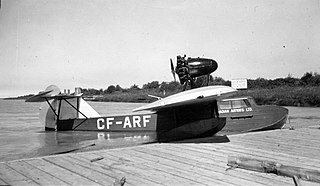 W
WA reconnaissance aircraft is a military aircraft designed or adapted to perform aerial reconnaissance with roles including collection of imagery intelligence, signals intelligence, as well as measurement and signature intelligence. Modern technology has also enabled some aircraft and UAVs to carry out real-time surveillance in addition to general intelligence gathering.
 W
WThe Boeing-Canada A-213 Totem was a Canadian single-engine pusher monoplane flying boat intended for forestry and fisheries patrols as well as a light utility transport for the British Columbia coastline, where there are few flat places for runways, and waterways are plentiful. The sole example, CF-ARF, CB10 was designed and built by Boeing Aircraft of Canada. The name refers to the Totem poles used by the First Nations in British Columbia.
 W
WThe de Havilland DH.98 Mosquito is a British twin-engined, shoulder-winged multirole combat aircraft, introduced during the Second World War. Unusual in that its frame was constructed mostly of wood, it was nicknamed the "Wooden Wonder", or "Mossie". Lord Beaverbrook, Minister of Aircraft Production, nicknamed it "Freeman's Folly", alluding to Air Chief Marshal Sir Wilfrid Freeman, who defended Geoffrey de Havilland and his design concept against orders to scrap the project. In 1941, it was one of the fastest operational aircraft in the world.
 W
WHelicam is a remote-controlled mini helicopter used to obtain aerial pictures or motion images using video, still or motion film cameras. The remote controlled camera mount system allows pan, tilt and roll movements. A wireless onboard video transmitter downlinks the live signal to the camera operator, images can be recorded on board, on the ground or both. The system is controlled by two operators with independent controls: the helicam pilot and camera operator.
 W
WThe Heterogeneous Aerial Reconnaissance Team (HART)—formerly known as the "Heterogeneous Urban RSTA Team (HURT)"—program was an aerial surveillance project funded by the Information Processing Technology Office of the Defense Advanced Research Projects Agency with program managers John Bay and Michael Pagels. The purpose of the program was to develop systems that could provide continuous, real-time, three-dimensional surveillance of large urbanized areas, using unmanned aerial vehicles. The project team was led by Northrop Grumman Corporation, and involved several other academic and corporate researchers.
 W
WAn observation balloon is a type of balloon that is employed as an aerial platform for intelligence gathering and artillery spotting. Use of observation balloons began during the French Revolutionary Wars, reaching their zenith during World War I, and they continue in limited use today.
 W
WObservation seaplanes are military aircraft with flotation devices allowing them to land on and take off from water. Their primary purpose was to observe and report enemy movements or to spot the fall of shot from naval artillery, but some were armed with machineguns or bombs. Their military usefulness extended from World War I through World War II. They were typically single-engine machines with catapult-launch capability and a crew of one, two or three. Most were designed to be carried aboard warships, but they also operated from seashore harbors.
 W
WThe Rogozarski R-313 was a two-seat twin-engined monoplane designed as a fighter/light bomber/reconnaissance aircraft in Yugoslavia before World War II. It was designed and built at the Rogozarski factory in Belgrade.